Elysia Tutorial
We will be building a small CRUD note-taking API server.
There's no database or other "production ready" features. This tutorial is going to only focus on Elysia feature and how to use Elysia only.
We expect it to take around 15-20 minutes if you follow along.
From other framework?
If you have used other popular frameworks like Express, Fastify, or Hono, you will find Elysia right at home with just a few differences.
Not a fan of tutorial?
If you prefer a more try-it-yourself approach, you can skip this tutorial and go straight to the key concept page to get a good understanding of how Elysia works.
llms.txt
Alternatively, you can download llms.txt or llms-full.txt and feed it to your favorite LLMs like ChatGPT, Claude or Gemini to get a more interactive experience.
Setup
Elysia is designed to run on Bun, an alternative runtime to Node.js but it can also run on Node.js or any runtime that support Web Standard API.
However, in this tutorial we will be using Bun.
Install Bun if you haven't already.
curl -fsSL https://bun.sh/install | bashpowershell -c "irm bun.sh/install.ps1 | iex"Create a new project
# Create a new project
bun create elysia hi-elysia
# cd into the project
cd hi-elysia
# Install dependencies
bun installThis will create a barebone project with Elysia and basic TypeScript config.
Start the development server
bun devOpen your browser and go to http://localhost:3000, you should see Hello Elysia message on the screen.
Elysia use Bun with --watch flag to automatically reload the server when you make changes.
Route
To add a new route, we specify an HTTP method, a pathname, and a value.
Let's start by opening the src/index.ts file as follows:
import { Elysia } from 'elysia'
const app = new Elysia()
.get('/', () => 'Hello Elysia')
.get('/hello', 'Do you miss me?')
.listen(3000)Open http://localhost:3000/hello, you should see Do you miss me?.
There are several HTTP methods we can use, but we will use the following for this tutorial:
- get
- post
- put
- patch
- delete
Other methods are available, use the same syntax as get
import { Elysia } from 'elysia'
const app = new Elysia()
.get('/', () => 'Hello Elysia')
.get('/hello', 'Do you miss me?')
.post('/hello', 'Do you miss me?')
.listen(3000)Elysia accepts both value and function as a response.
However, we can use function to access Context (route and instance information).
import { Elysia } from 'elysia'
const app = new Elysia()
.get('/', () => 'Hello Elysia')
.get('/', ({ path }) => path)
.post('/hello', 'Do you miss me?')
.listen(3000)OpenAPI
Entering a URL to the browser can only interact with the GET method. To interact with other methods, we need a REST Client like Postman or Insomnia.
Luckily, Elysia comes with a OpenAPI Schema with Scalar to interact with our API.
# Install the OpenAPI plugin
bun add @elysiajs/openapiThen apply the plugin to the Elysia instance.
import { Elysia } from 'elysia'
import { openapi } from '@elysiajs/openapi'
const app = new Elysia()
// Apply the openapi plugin
.use(openapi())
.get('/', ({ path }) => path)
.post('/hello', 'Do you miss me?')
.listen(3000)Navigate to http://localhost:3000/openapi, you should see the documentation like this: 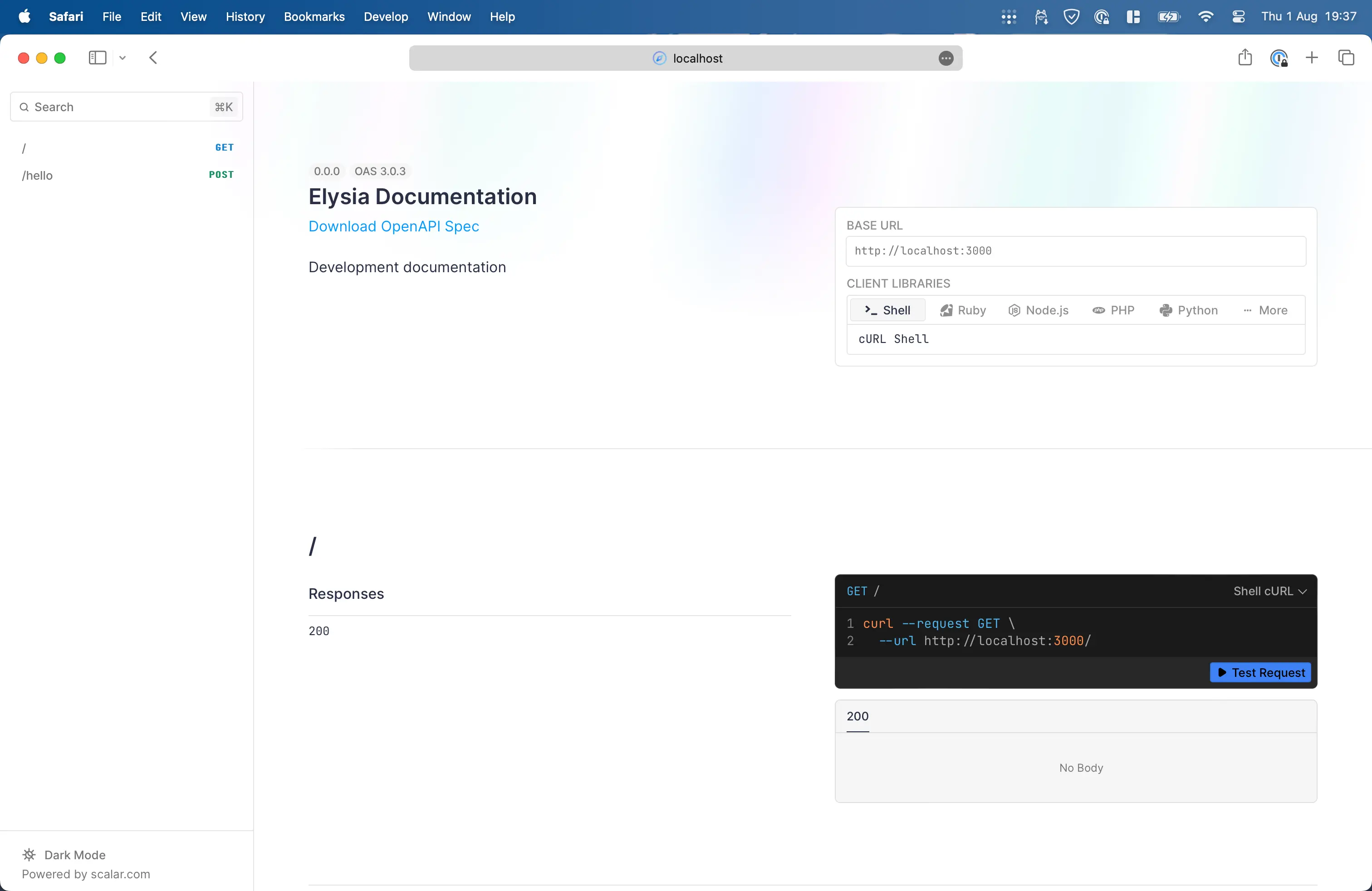
Now we can interact with all the routes we have created.
Scroll to /hello and click a blue Test Request button to show the form.
We can see the result by clicking the black Send button. 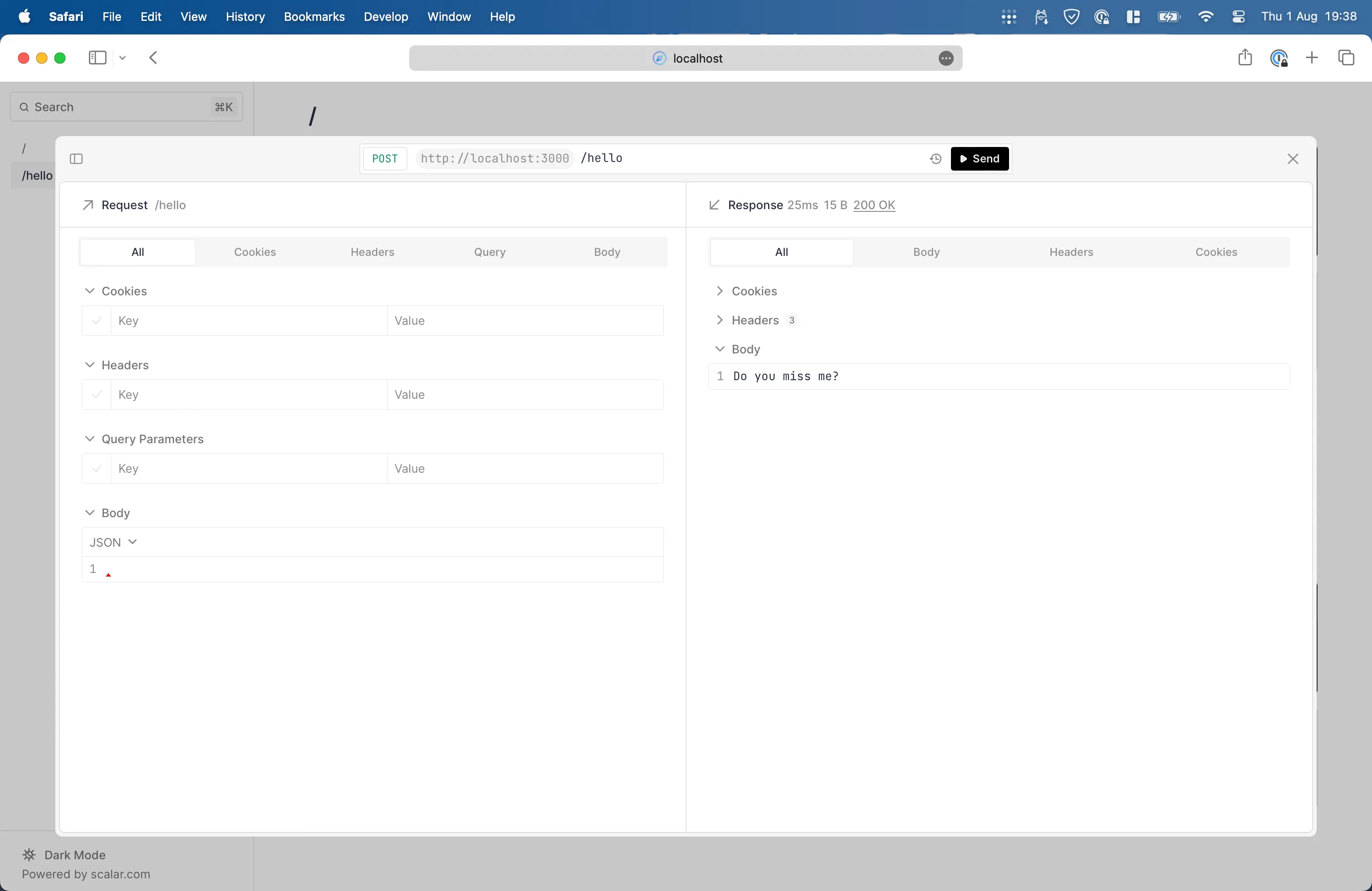
Decorate
However, for more complex data we may want to use class for complex data as it allows us to define custom methods and properties.
Now, let's create a singleton class to store our notes.
import { Elysia } from 'elysia'
import { openapi } from '@elysiajs/openapi'
class Note {
constructor(public data: string[] = ['Moonhalo']) {}
}
const app = new Elysia()
.use(openapi())
.decorate('note', new Note())
.get('/note', ({ note }) => note.data)
.listen(3000)decorate allows us to inject a singleton class into the Elysia instance, allowing us to access it in the route handler.
Open http://localhost:3000/note, we should see ["Moonhalo"] on the screen.
For Scalar documentation, we may need to reload the page to see the new changes. 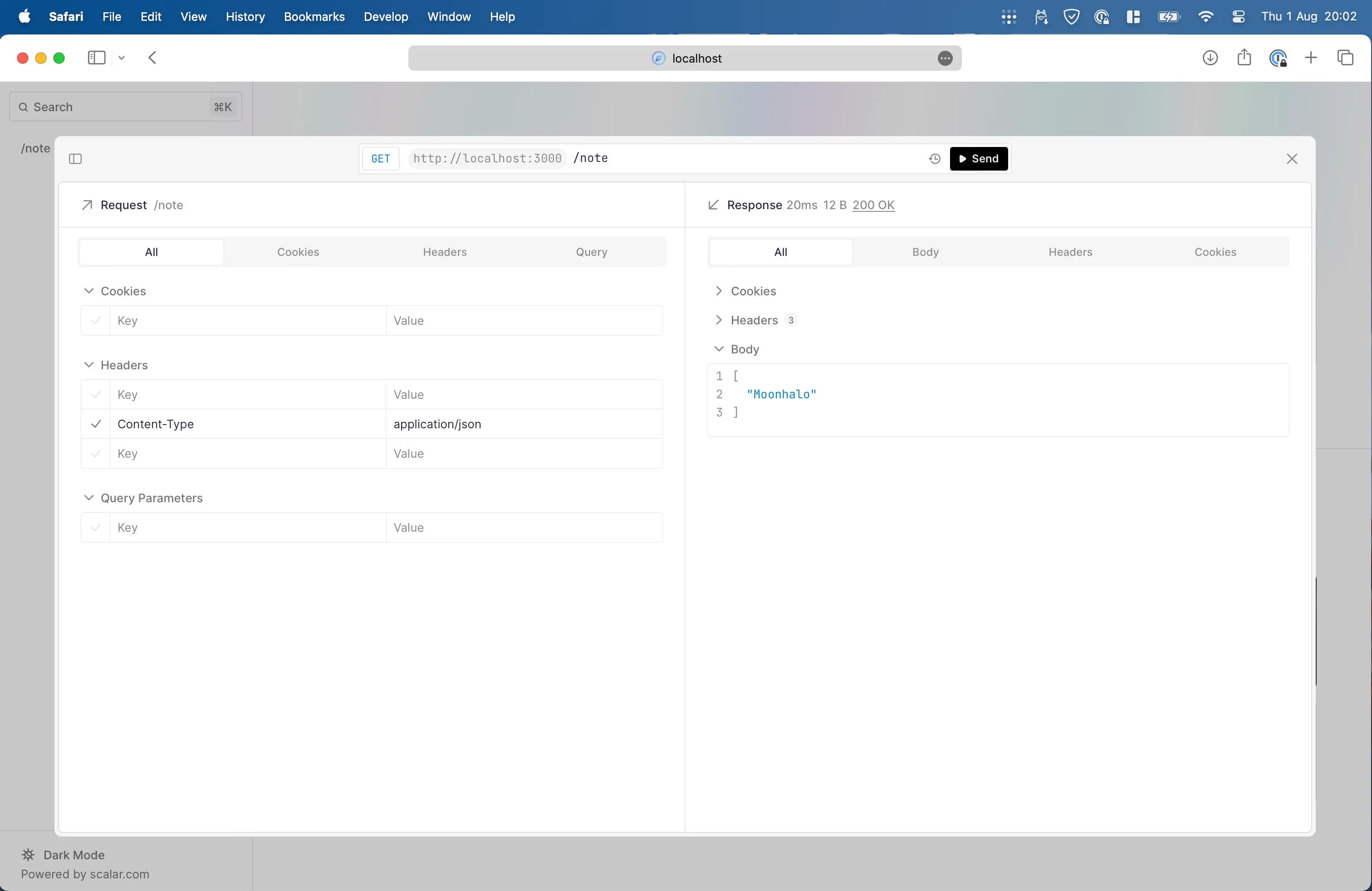
Path parameter
Now let's retrieve a note by its index.
We can define a path parameter by prefixing it with a colon.
import { Elysia } from 'elysia'
import { openapi } from '@elysiajs/openapi'
class Note {
constructor(public data: string[] = ['Moonhalo']) {}
}
const app = new Elysia()
.use(openapi())
.decorate('note', new Note())
.get('/note', ({ note }) => note.data)
.get('/note/:index', ({ note, params: { index } }) => {
return note.data[index] })
.listen(3000)Let's ignore the error for now.
Open http://localhost:3000/note/0, we should see Moonhalo on the screen.
The path parameter allows us to retrieve a specific part from the URL. In our case, we retrieve a "0" from /note/0 put into a variable named index.
Validation
The error above is a warning that the path parameter can be any string, while an array index should be a number.
For example, /note/0 is valid, but /note/zero is not.
We can enforce and validate type by declaring a schema:
import { Elysia, t } from 'elysia'
import { openapi } from '@elysiajs/openapi'
class Note {
constructor(public data: string[] = ['Moonhalo']) {}
}
const app = new Elysia()
.use(openapi())
.decorate('note', new Note())
.get('/note', ({ note }) => note.data)
.get(
'/note/:index',
({ note, params: { index } }) => {
return note.data[index]
},
{
params: t.Object({
index: t.Number()
})
}
)
.listen(3000)We import t from Elysia to define a schema for the path parameter.
Now, if we try to access http://localhost:3000/note/abc, we should see an error message.
This code resolves the error we saw earlier because of a TypeScript warning.
Elysia schema doesn't only enforce validation on the runtime, but it also infers a TypeScript type for auto-completion and checking error ahead of time, and a Scalar documentation.
Most frameworks provide only one of these features or provide them separately requiring us to update each one separately, but Elysia provides all of them as a Single Source of Truth.
Validation type
Elysia provides validation for the following properties:
- params - path parameter
- query - URL querystring
- body - request body
- headers - request headers
- cookie - cookie
- response - response body
All of them share the same syntax as the example above.
Status code
By default, Elysia will return a status code of 200 for all routes even if the response is an error.
For example, if we try to access http://localhost:3000/note/1, we should see undefined on the screen which shouldn't be a 200 status code (OK).
We can change the status code by returning an error
import { Elysia, t } from 'elysia'
import { openapi } from '@elysiajs/openapi'
class Note {
constructor(public data: string[] = ['Moonhalo']) {}
}
const app = new Elysia()
.use(openapi())
.decorate('note', new Note())
.get('/note', ({ note }) => note.data)
.get(
'/note/:index',
({ note, params: { index }, status }) => {
return note.data[index] ?? status(404)
},
{
params: t.Object({
index: t.Number()
})
}
)
.listen(3000)Now, if we try to access http://localhost:3000/note/1, we should see Not Found on the screen with a status code of 404.
We can also return a custom message by passing a string to the error function.
import { Elysia, t } from 'elysia'
import { openapi } from '@elysiajs/openapi'
class Note {
constructor(public data: string[] = ['Moonhalo']) {}
}
const app = new Elysia()
.use(openapi())
.decorate('note', new Note())
.get('/note', ({ note }) => note.data)
.get(
'/note/:index',
({ note, params: { index }, status }) => {
return note.data[index] ?? status(404, 'oh no :(')
},
{
params: t.Object({
index: t.Number()
})
}
)
.listen(3000)Plugin
The main instance is starting to get crowded, we can move the route handler to a separate file and import it as a plugin.
Create a new file named note.ts:
import { Elysia, t } from 'elysia'
class Note {
constructor(public data: string[] = ['Moonhalo']) {}
}
export const note = new Elysia()
.decorate('note', new Note())
.get('/note', ({ note }) => note.data)
.get(
'/note/:index',
({ note, params: { index }, status }) => {
return note.data[index] ?? status(404, 'oh no :(')
},
{
params: t.Object({
index: t.Number()
})
}
)Then on the index.ts, apply note into the main instance:
import { Elysia, t } from 'elysia'
import { openapi } from '@elysiajs/openapi'
import { note } from './note'
class Note {
constructor(public data: string[] = ['Moonhalo']) {}
}
const app = new Elysia()
.use(openapi())
.use(note)
.decorate('note', new Note())
.get('/note', ({ note }) => note.data)
.get(
'/note/:index',
({ note, params: { index }, status }) => {
return note.data[index] ?? status(404, 'oh no :(')
},
{
params: t.Object({
index: t.Number()
})
}
)
.listen(3000)Open http://localhost:3000/note/1 and you should see oh no :( again like before.
We have just created a note plugin, by declaring a new Elysia instance.
Each plugin is a separate instance of Elysia which has its own routes, middlewares, and decorators which can be applied to other instances.
Applying CRUD
We can apply the same pattern to create, update, and delete routes.
import { Elysia, t } from 'elysia'
class Note {
constructor(public data: string[] = ['Moonhalo']) {}
add(note: string) {
this.data.push(note)
return this.data
}
remove(index: number) {
return this.data.splice(index, 1)
}
update(index: number, note: string) {
return (this.data[index] = note)
}
}
export const note = new Elysia()
.decorate('note', new Note())
.get('/note', ({ note }) => note.data)
.put('/note', ({ note, body: { data } }) => note.add(data), {
body: t.Object({
data: t.String()
})
})
.get(
'/note/:index',
({ note, params: { index }, status }) => {
return note.data[index] ?? status(404, 'Not Found :(')
},
{
params: t.Object({
index: t.Number()
})
}
)
.delete(
'/note/:index',
({ note, params: { index }, status }) => {
if (index in note.data) return note.remove(index)
return status(422)
},
{
params: t.Object({
index: t.Number()
})
}
)
.patch(
'/note/:index',
({ note, params: { index }, body: { data }, status }) => {
if (index in note.data) return note.update(index, data)
return status(422)
},
{
params: t.Object({
index: t.Number()
}),
body: t.Object({
data: t.String()
})
}
) Now let's open http://localhost:3000/openapi and try playing around with CRUD operations.
Group
If we look closely, all of the routes in the note plugin share a /note prefix.
We can simplify this by declaring prefix
export const note = new Elysia({ prefix: '/note' })
.decorate('note', new Note())
.get('/', ({ note }) => note.data)
.put('/', ({ note, body: { data } }) => note.add(data), {
body: t.Object({
data: t.String()
})
})
.get(
'/:index',
({ note, params: { index }, status }) => {
return note.data[index] ?? status(404, 'Not Found :(')
},
{
params: t.Object({
index: t.Number()
})
}
)
.delete(
'/:index',
({ note, params: { index }, status }) => {
if (index in note.data) return note.remove(index)
return status(422)
},
{
params: t.Object({
index: t.Number()
})
}
)
.patch(
'/:index',
({ note, params: { index }, body: { data }, status }) => {
if (index in note.data) return note.update(index, data)
return status(422)
},
{
params: t.Object({
index: t.Number()
}),
body: t.Object({
data: t.String()
})
}
)Guard
Now we may notice that there are several routes in plugin that has params validation.
We may define a guard to apply validation to routes in the plugin.
export const note = new Elysia({ prefix: '/note' })
.decorate('note', new Note())
.get('/', ({ note }) => note.data)
.put('/', ({ note, body: { data } }) => note.add(data), {
body: t.Object({
data: t.String()
})
})
.guard({
params: t.Object({
index: t.Number()
})
})
.get(
'/:index',
({ note, params: { index }, status }) => {
return note.data[index] ?? status(404, 'Not Found :(')
},
{
params: t.Object({
index: t.Number()
})
}
)
.delete(
'/:index',
({ note, params: { index }, status }) => {
if (index in note.data) return note.remove(index)
return status(422)
},
{
params: t.Object({
index: t.Number()
})
}
)
.patch(
'/:index',
({ note, params: { index }, body: { data }, status }) => {
if (index in note.data) return note.update(index, data)
return status(422)
},
{
params: t.Object({
index: t.Number()
}),
body: t.Object({
data: t.String()
})
}
)Validation will be applied to all routes after guard is called and tied to the plugin.
Lifecycle
Now in real-world usage, we may want to do something like logging before the request is processed.
Instead of inline console.log for each route, we may apply a lifecycle that intercepts the request before/after it is processed.
There are several lifecycles that we can use, but in this case we will be using onTransform.
export const note = new Elysia({ prefix: '/note' })
.decorate('note', new Note())
.onTransform(function log({ body, params, path, request: { method } }) {
console.log(`${method} ${path}`, {
body,
params
})
})
.get('/', ({ note }) => note.data)
.put('/', ({ note, body: { data } }) => note.add(data), {
body: t.Object({
data: t.String()
})
})
.guard({
params: t.Object({
index: t.Number()
})
})
.get('/:index', ({ note, params: { index }, status }) => {
return note.data[index] ?? status(404, 'Not Found :(')
})
.delete('/:index', ({ note, params: { index }, status }) => {
if (index in note.data) return note.remove(index)
return status(422)
})
.patch(
'/:index',
({ note, params: { index }, body: { data }, status }) => {
if (index in note.data) return note.update(index, data)
return status(422)
},
{
body: t.Object({
data: t.String()
})
}
)onTransform is called after routing but before validation, so we can do something like logging the request that is defined without triggering the 404 Not found route.
This allows us to log the request before it is processed, and we can see the request body and path parameters.
Scope
By default, the lifecycle hook is encapsulated. Hook is applied to routes in the same instance, and is not applied to other plugins (routes that are not defined in the same plugin).
This means the log function, in the onTransform hook, will not be called on other instances, unless we explicitly defined it as scoped or global.
Authentication
Now we may want to add restrictions to our routes, so only the owner of the note can update or delete it.
Let's create a user.ts file that will handle the user authentication:
import { Elysia, t } from 'elysia'
export const user = new Elysia({ prefix: '/user' })
.state({
user: {} as Record<string, string>,
session: {} as Record<number, string>
})
.put(
'/sign-up',
async ({ body: { username, password }, store, status }) => {
if (store.user[username])
return status(400, {
success: false,
message: 'User already exists'
})
store.user[username] = await Bun.password.hash(password)
return {
success: true,
message: 'User created'
}
},
{
body: t.Object({
username: t.String({ minLength: 1 }),
password: t.String({ minLength: 8 })
})
}
)
.post(
'/sign-in',
async ({
store: { user, session },
status,
body: { username, password },
cookie: { token }
}) => {
if (
!user[username] ||
!(await Bun.password.verify(password, user[username]))
)
return status(400, {
success: false,
message: 'Invalid username or password'
})
const key = crypto.getRandomValues(new Uint32Array(1))[0]
session[key] = username
token.value = key
return {
success: true,
message: `Signed in as ${username}`
}
},
{
body: t.Object({
username: t.String({ minLength: 1 }),
password: t.String({ minLength: 8 })
}),
cookie: t.Cookie(
{
token: t.Number()
},
{
secrets: 'seia'
}
)
}
) Now there are a lot of things to unwrap here:
- We create a new instance with 2 routes for sign up and sign in.
- In the instance, we define an in-memory store
userandsession- 2.1
userwill hold key-value ofusernameandpassword - 2.2
sessionwill hold a key-value ofsessionandusername
- 2.1
- In
/sign-upwe insert a username and hashed password with argon2id - In
/sign-inwe do the following:- 4.1 We check if user exists and verify the password
- 4.2 If the password matches, then we generate a new session into
session - 4.3 We set cookie
tokenwith the value of session - 4.4 We append
secretto cookie to add hash and block an attacker from tampering with the cookie
TIP
As we are using an in-memory store, the data are wiped out every reload or every time we edit the code.
We will fix that in the later part of the tutorial.
Now if we want to check if a user is signed in, we could check for value of token cookie and check with the session store.
Reference Model
However, we can recognize that both /sign-in and /sign-up both share the same body model.
Instead of copy-pasting the model all over the place, we could use a reference model to reuse the model by specifying a name.
To create a reference model, we may use .model and pass the name and the value of models:
import { Elysia, t } from 'elysia'
export const user = new Elysia({ prefix: '/user' })
.state({
user: {} as Record<string, string>,
session: {} as Record<number, string>
})
.model({
signIn: t.Object({
username: t.String({ minLength: 1 }),
password: t.String({ minLength: 8 })
}),
session: t.Cookie(
{
token: t.Number()
},
{
secrets: 'seia'
}
),
optionalSession: t.Cookie(
{
token: t.Optional(t.Number())
},
{
secrets: 'seia'
}
)
})
.put(
'/sign-up',
async ({ body: { username, password }, store, status }) => {
if (store.user[username])
return status(400, {
success: false,
message: 'User already exists'
})
store.user[username] = await Bun.password.hash(password)
return {
success: true,
message: 'User created'
}
},
{
body: 'signIn'
}
)
.post(
'/sign-in',
async ({
store: { user, session },
status,
body: { username, password },
cookie: { token }
}) => {
if (
!user[username] ||
!(await Bun.password.verify(password, user[username]))
)
return status(400, {
success: false,
message: 'Invalid username or password'
})
const key = crypto.getRandomValues(new Uint32Array(1))[0]
session[key] = username
token.value = key
return {
success: true,
message: `Signed in as ${username}`
}
},
{
body: 'signIn',
cookie: 'session'
}
)After adding a model/models, we can reuse them by referencing their name in the schema instead of providing a literal type while providing the same functionality and type safety.
Elysia.model could accept multiple overloads:
- Providing an object, the register all key-value as models
- Providing a function, then access all previous models then return new models
Finally, we could add the /profile and /sign-out routes as follows:
import { Elysia, t } from 'elysia'
export const user = new Elysia({ prefix: '/user' })
.state({
user: {} as Record<string, string>,
session: {} as Record<number, string>
})
.model({
signIn: t.Object({
username: t.String({ minLength: 1 }),
password: t.String({ minLength: 8 })
}),
session: t.Cookie(
{
token: t.Number()
},
{
secrets: 'seia'
}
),
optionalSession: t.Cookie(
{
token: t.Optional(t.Number())
},
{
secrets: 'seia'
}
)
})
.put(
'/sign-up',
async ({ body: { username, password }, store, status }) => {
if (store.user[username])
return status(400, {
success: false,
message: 'User already exists'
})
store.user[username] = await Bun.password.hash(password)
return {
success: true,
message: 'User created'
}
},
{
body: 'signIn'
}
)
.post(
'/sign-in',
async ({
store: { user, session },
status,
body: { username, password },
cookie: { token }
}) => {
if (
!user[username] ||
!(await Bun.password.verify(password, user[username]))
)
return status(400, {
success: false,
message: 'Invalid username or password'
})
const key = crypto.getRandomValues(new Uint32Array(1))[0]
session[key] = username
token.value = key
return {
success: true,
message: `Signed in as ${username}`
}
},
{
body: 'signIn',
cookie: 'optionalSession'
}
)
.get(
'/sign-out',
({ cookie: { token } }) => {
token.remove()
return {
success: true,
message: 'Signed out'
}
},
{
cookie: 'optionalSession'
}
)
.get(
'/profile',
({ cookie: { token }, store: { session }, status }) => {
const username = session[token.value]
if (!username)
return status(401, {
success: false,
message: 'Unauthorized'
})
return {
success: true,
username
}
},
{
cookie: 'session'
}
) As we are going to apply authorization in the note, we are going to need to repeat two things:
- Checking if user exists
- Getting user id (in our case 'username')
For 1. instead of using guard, we could use a macro.
Plugin deduplication
As we are going to reuse this hook in multiple modules (user, and note), let's extract the service (utility) part out and apply it to both modules.
// @errors: 2538
import { Elysia, t } from 'elysia'
export const userService = new Elysia({ name: 'user/service' })
.state({
user: {} as Record<string, string>,
session: {} as Record<number, string>
})
.model({
signIn: t.Object({
username: t.String({ minLength: 1 }),
password: t.String({ minLength: 8 })
}),
session: t.Cookie(
{
token: t.Number()
},
{
secrets: 'seia'
}
),
optionalSession: t.Cookie(
{
token: t.Optional(t.Number())
},
{
secrets: 'seia'
}
)
})
export const user = new Elysia({ prefix: '/user' })
.use(userService)
.state({
user: {} as Record<string, string>,
session: {} as Record<number, string>
})
.model({
signIn: t.Object({
username: t.String({ minLength: 1 }),
password: t.String({ minLength: 8 })
}),
session: t.Cookie(
{
token: t.Number()
},
{
secrets: 'seia'
}
),
optionalSession: t.Cookie(
{
token: t.Optional(t.Number())
},
{
secrets: 'seia'
}
)
}) The name property here is very important, as it's a unique identifier for the plugin to prevent duplicate instances (like a singleton).
If we were to define the instance without the plugin, hook/lifecycle and routes are going to be registered every time the plugin is used.
Our intention is to apply this plugin (service) to multiple modules to provide utility function, this make deduplication very important as life-cycle shouldn't be registered twice.
Macro
Macro allows us to define a custom hook with custom life-cycle management.
To define a macro, we could use .macro as follows:
import { Elysia, t } from 'elysia'
export const userService = new Elysia({ name: 'user/service' })
.state({
user: {} as Record<string, string>,
session: {} as Record<number, string>
})
.model({
signIn: t.Object({
username: t.String({ minLength: 1 }),
password: t.String({ minLength: 8 })
}),
session: t.Cookie(
{
token: t.Number()
},
{
secrets: 'seia'
}
),
optionalSession: t.Cookie(
{
token: t.Optional(t.Number())
},
{
secrets: 'seia'
}
)
})
.macro({
isSignIn(enabled: boolean) {
if (!enabled) return
return {
beforeHandle({
status,
cookie: { token },
store: { session }
}) {
if (!token.value)
return status(401, {
success: false,
message: 'Unauthorized'
})
const username = session[token.value as unknown as number]
if (!username)
return status(401, {
success: false,
message: 'Unauthorized'
})
}
}
}
}) We have just created a new macro name isSignIn that accepts a boolean value, if it is true, then we add an onBeforeHandle event that executes after validation but before the main handler, allowing us to extract authentication logic here.
To use the macro, simply specify isSignIn: true as follows:
import { Elysia, t } from 'elysia'
export const user = new Elysia({ prefix: '/user' }).use(userService).get(
'/profile',
({ cookie: { token }, store: { session }, status }) => {
const username = session[token.value]
if (!username)
return status(401, {
success: false,
message: 'Unauthorized'
})
return {
success: true,
username
}
},
{
isSignIn: true,
cookie: 'session'
}
)As we specified isSignIn, we can extract the imperative checking part, and reuse the same logic on multiple routes without copy-pasting the same code all over again.
TIP
This may seem like a small code change to trade for a larger boilerplate, but as the server grows more complex, the user-checking could also grow to be a very complex mechanism.
Resolve
Our last objective is to get the username (id) from the token. We could use resolve to define a new property into the same context as store but only execute it per request.
Unlike decorate and store, resolve is defined at the beforeHandle stage or the value will be available after validation.
This ensures that the property like cookie: 'session' exists before creating a new property.
export const getUserId = new Elysia()
.use(userService)
.guard({
cookie: 'session'
})
.resolve(({ store: { session }, cookie: { token } }) => ({
username: session[token.value]
})) In this instance, we define a new property username by using resolve, allowing us to reduce the getting username logic into a property instead.
We don't define a name in this getUserId instance because we want guard and resolve to reapply into multiple instances.
TIP
Same as macro, resolve plays well if the logic for getting the property is complex and might not be worth it for a small operation like this. But since in the real-world we are going to need database-connection, caching, and queuing it might make it fit the narrative.
Scope
Now if we try to apply the use of the getUserId, we might notice that the property username and guard isn't applied.
export const getUserId = new Elysia()
.use(userService)
.guard({
isSignIn: true,
cookie: 'session'
})
.resolve(({ store: { session }, cookie: { token } }) => ({
username: session[token.value]
}))
export const user = new Elysia({ prefix: '/user' })
.use(getUserId)
.get('/profile', ({ username }) => ({
success: true,
username
}))This is because the Elysia encapsulate lifecycle does this by default as mentioned in lifecycle
This is intentional by design, as we don't want each module to have a side-effect to other modules. Having a side-effect can be very difficult to debug especially in a large codebase with multiple (Elysia) dependencies.
If we want lifecycle to be applied to the parent, we can explicitly annotate that it could be applied to the parent by using either:
- scoped - only apply to parent at 1-level above and not any further
- global - apply to all parent levels
In our case, we want to use scoped as it will apply to the controller that uses the service only.
To do this, we need to annotate that life-cycle as scoped:
export const getUserId = new Elysia()
.use(userService)
.guard({
as: 'scoped',
isSignIn: true,
cookie: 'session'
})
.resolve(
{ as: 'scoped' },
({ store: { session }, cookie: { token } }) => ({
username: session[token.value]
})
)
export const user = new Elysia({ prefix: '/user' })
.use(getUserId)
.get('/profile', ({ username }) => ({
// ^?
success: true,
username
}))Alternatively, if we have multiple scoped defined, we could use as to cast multiple life-cycles instead.
export const getUserId = new Elysia()
.use(userService)
.guard({
as: 'scoped',
isSignIn: true,
cookie: 'session'
})
.resolve(
{ as: 'scoped' },
({ store: { session }, cookie: { token } }) => ({
username: session[token.value]
})
)
.as('scoped')
export const user = new Elysia({ prefix: '/user' })
.use(getUserId)
.get('/profile', ({ username }) => ({
success: true,
username
}))Both achieve the same effect, the only difference is single or multiple cast instances.
TIP
Encapsulation happens in both runtime, and type-level. This allows us to catch the error ahead of time.
Lastly, we can reuse userService and getUserId to help with authorization in our note controller.
But first, don't forget to import the user in the index.ts file:
import { Elysia, t } from 'elysia'
import { openapi } from '@elysiajs/openapi'
import { note } from './note'
import { user } from './user'
const app = new Elysia()
.use(openapi())
.use(user)
.use(note)
.listen(3000)Authorization
First, let's modify the Note class to store the user who created the note.
But instead of defining the Memo type, we can define a memo schema and infer the type from it, allowing us to sync runtime and type-level.
import { Elysia, t } from 'elysia'
const memo = t.Object({
data: t.String(),
author: t.String()
})
type Memo = typeof memo.static
class Note {
constructor(public data: string[] = ['Moonhalo']) {}
constructor(
public data: Memo[] = [
{
data: 'Moonhalo',
author: 'saltyaom'
}
]
) {}
add(note: string) {
add(note: Memo) {
this.data.push(note)
return this.data
}
remove(index: number) {
return this.data.splice(index, 1)
}
update(index: number, note: string) {
return (this.data[index] = note)
}
update(index: number, note: Partial<Memo>) {
return (this.data[index] = { ...this.data[index], ...note })
}
}
export const note = new Elysia({ prefix: '/note' })
.decorate('note', new Note())
.model({
memo: t.Omit(memo, ['author'])
})
.onTransform(function log({ body, params, path, request: { method } }) {
console.log(`${method} ${path}`, {
body,
params
})
})
.get('/', ({ note }) => note.data)
.put('/', ({ note, body: { data } }) => note.add(data), {
body: t.Object({
data: t.String()
}),
})
.put('/', ({ note, body: { data }, username }) =>
note.add({ data, author: username }),
{
body: 'memo'
}
)
.guard({
params: t.Object({
index: t.Number()
})
})
.get(
'/:index',
({ note, params: { index }, status }) => {
return note.data[index] ?? status(404, 'Not Found :(')
}
)
.delete(
'/:index',
({ note, params: { index }, status }) => {
if (index in note.data) return note.remove(index)
return status(422)
}
)
.patch(
'/:index',
({ note, params: { index }, body: { data }, status }) => {
if (index in note.data) return note.update(index, data)
({ note, params: { index }, body: { data }, status, username }) => {
if (index in note.data)
return note.update(index, { data, author: username }))
return status(422)
},
{
body: t.Object({
data: t.String()
}),
body: 'memo'
}
)Now let's import, and use userService, getUserId to apply authorization to the note controller.
import { Elysia, t } from 'elysia'
import { getUserId, userService } from './user'
const memo = t.Object({
data: t.String(),
author: t.String()
})
type Memo = typeof memo.static
class Note {
constructor(
public data: Memo[] = [
{
data: 'Moonhalo',
author: 'saltyaom'
}
]
) {}
add(note: Memo) {
this.data.push(note)
return this.data
}
remove(index: number) {
return this.data.splice(index, 1)
}
update(index: number, note: Partial<Memo>) {
return (this.data[index] = { ...this.data[index], ...note })
}
}
export const note = new Elysia({ prefix: '/note' })
.use(userService)
.decorate('note', new Note())
.model({
memo: t.Omit(memo, ['author'])
})
.onTransform(function log({ body, params, path, request: { method } }) {
console.log(`${method} ${path}`, {
body,
params
})
})
.get('/', ({ note }) => note.data)
.use(getUserId)
.put(
'/',
({ note, body: { data }, username }) =>
note.add({ data, author: username }),
{
body: 'memo'
}
)
.get(
'/:index',
({ note, params: { index }, status }) => {
return note.data[index] ?? status(404, 'Not Found :(')
},
{
params: t.Object({
index: t.Number()
})
}
)
.guard({
params: t.Object({
index: t.Number()
})
})
.delete('/:index', ({ note, params: { index }, status }) => {
if (index in note.data) return note.remove(index)
return status(422)
})
.patch(
'/:index',
({ note, params: { index }, body: { data }, status, username }) => {
if (index in note.data)
return note.update(index, { data, author: username })
return status(422)
},
{
isSignIn: true,
body: 'memo'
}
)And that's it 🎉
We have just implemented authorization by reusing the service we created earlier.
Error handling
One of the most important aspects of an API is to make sure nothing goes wrong, and if it does, we need to handle it properly.
We use use the onError lifecycle to catch any error that is thrown in the server.
import { Elysia, t } from 'elysia'
import { openapi } from '@elysiajs/openapi'
import { note } from './note'
import { user } from './user'
const app = new Elysia()
.use(openapi())
.onError(({ error, code }) => {
if (code === 'NOT_FOUND') return
console.error(error)
})
.use(user)
.use(note)
.listen(3000)We have just added an error listener that will catch any error that is thrown in the server, excluding 404 Not Found and log it to the console.
TIP
Notice that onError is used before use(note). This is important as Elysia applies the method from top-to-bottom. The listener has to be applied before the route.
And as onError is applied on the root instance, it doesn't need to define a scope as it will apply to all children instances.
Returning a truthy value will override a default error response, so we can return a custom error response which inherits the status code.
import { Elysia, t } from 'elysia'
import { openapi } from '@elysiajs/openapi'
import { note } from './note'
const app = new Elysia()
.use(openapi())
.onError(({ error, code }) => {
if (code === 'NOT_FOUND') return 'Not Found :('
console.error(error)
})
.use(note)
.listen(3000)Observability
Now we have a working API, a final touch is to make sure everything is working after we deployed our server.
Elysia supports OpenTelemetry by default with the @elysiajs/opentelemetry plugin.
bun add @elysiajs/opentelemetryMake sure to have an OpenTelemetry collector running otherwise we will be using Jaeger from docker.
docker run --name jaeger \
-e COLLECTOR_ZIPKIN_HOST_PORT=:9411 \
-e COLLECTOR_OTLP_ENABLED=true \
-p 6831:6831/udp \
-p 6832:6832/udp \
-p 5778:5778 \
-p 16686:16686 \
-p 4317:4317 \
-p 4318:4318 \
-p 14250:14250 \
-p 14268:14268 \
-p 14269:14269 \
-p 9411:9411 \
jaegertracing/all-in-one:latestNow let's apply the OpenTelemetry plugin to our server.
import { Elysia, t } from 'elysia'
import { opentelemetry } from '@elysiajs/opentelemetry'
import { openapi } from '@elysiajs/openapi'
import { note } from './note'
import { user } from './user'
const app = new Elysia()
.use(opentelemetry())
.use(openapi())
.onError(({ error, code }) => {
if (code === 'NOT_FOUND') return 'Not Found :('
console.error(error)
})
.use(note)
.use(user)
.listen(3000)Now try out some more requests and open http://localhost:16686 to see traces.
Select service Elysia and click on Find Traces, we should be able to see a list of requests that we have made.
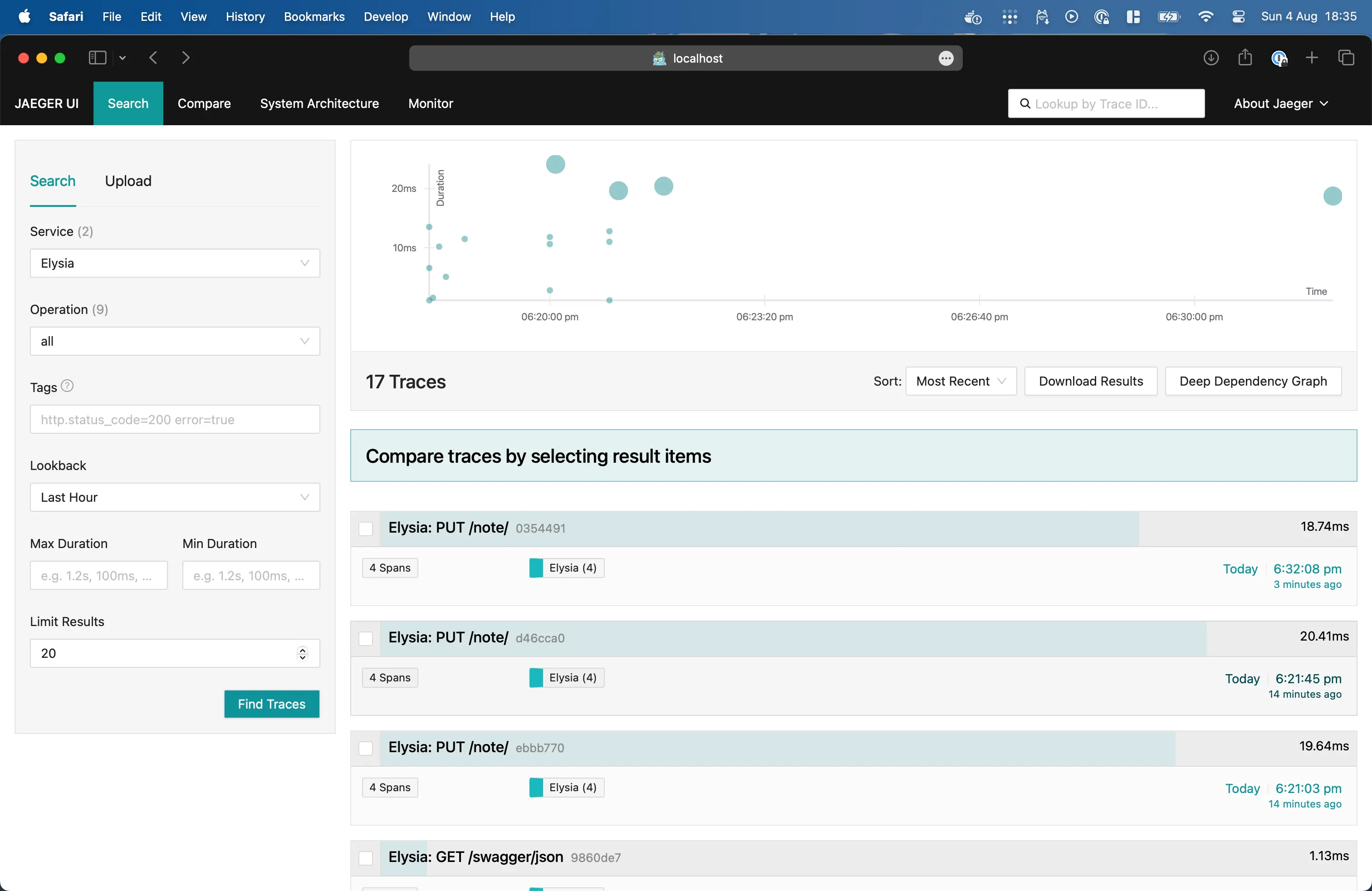
Click on any of the requests to see how long each lifecycle hook takes to process the request. 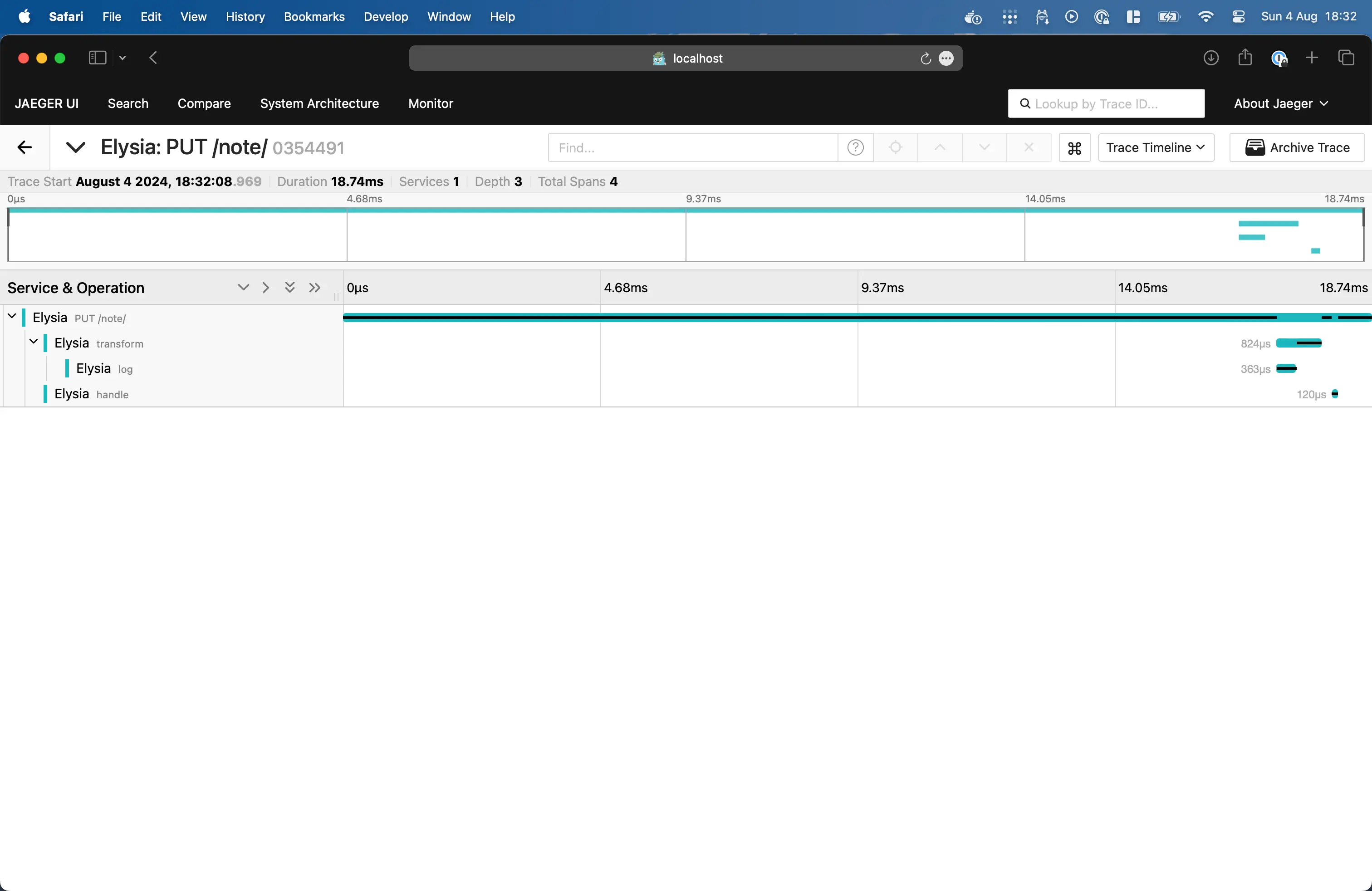
Click on the root parent span to see the request details, this will show you the request and response payload, and errors if have any. 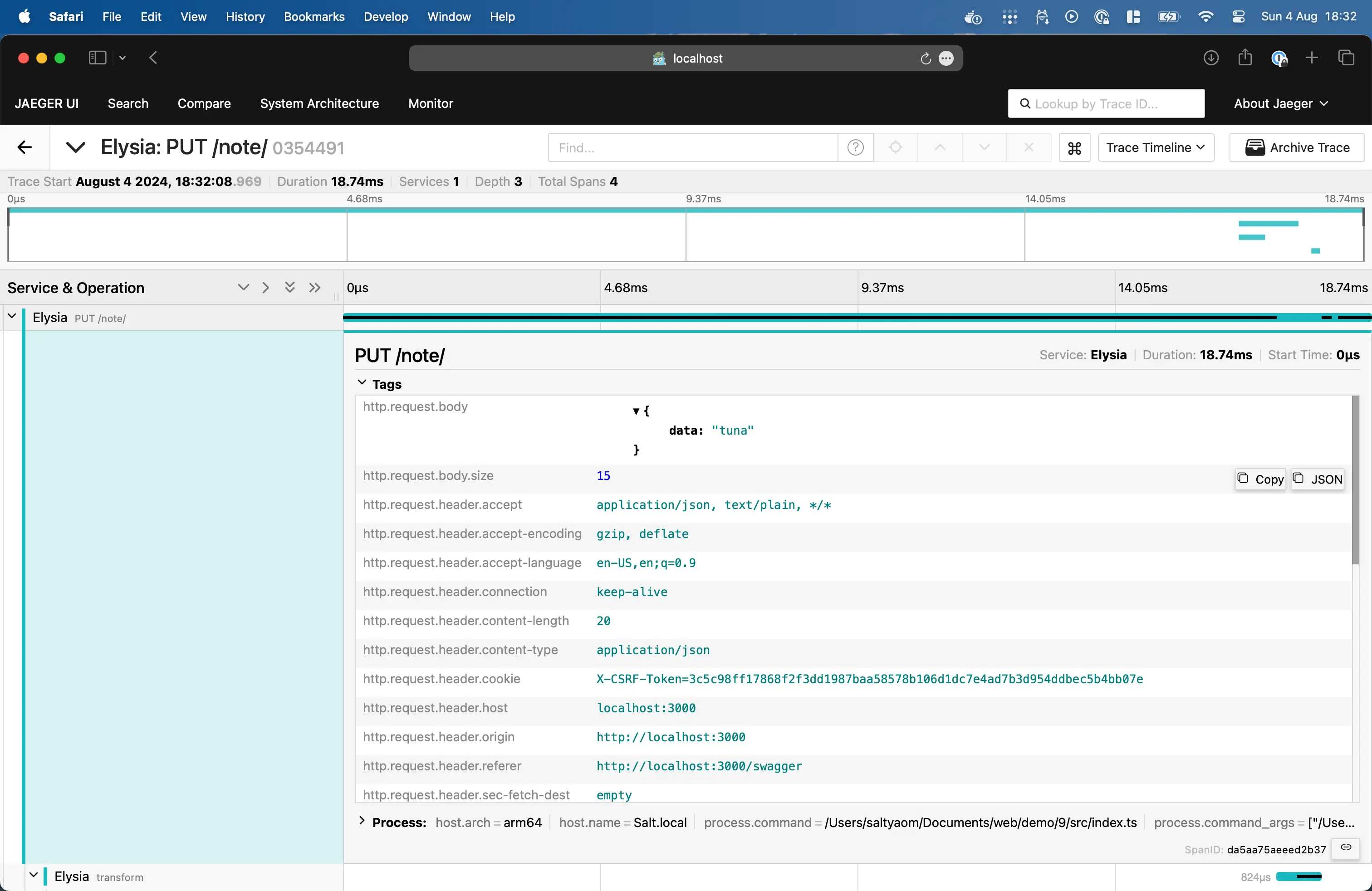
Elysia supports OpenTelemetry out of the box, it automatically integrates with other JavaScript libraries that support OpenTelemetry like Prisma, GraphQL Yoga, Effect, etc.
You can also use other OpenTelemetry plugins to send traces to other services like Zipkin, Prometheus, etc.
Codebase recap
If you are following along, you should have a codebase that looks like this:
import { Elysia } from 'elysia'
import { openapi } from '@elysiajs/openapi'
import { opentelemetry } from '@elysiajs/opentelemetry'
import { note } from './note'
import { user } from './user'
const app = new Elysia()
.use(opentelemetry())
.use(openapi())
.onError(({ error, code }) => {
if (code === 'NOT_FOUND') return 'Not Found :('
console.error(error)
})
.use(user)
.use(note)
.listen(3000)import { Elysia, t } from 'elysia'
export const userService = new Elysia({ name: 'user/service' })
.state({
user: {} as Record<string, string>,
session: {} as Record<number, string>
})
.model({
signIn: t.Object({
username: t.String({ minLength: 1 }),
password: t.String({ minLength: 8 })
}),
session: t.Cookie(
{
token: t.Number()
},
{
secrets: 'seia'
}
),
optionalSession: t.Cookie(
{
token: t.Optional(t.Number())
},
{
secrets: 'seia'
}
)
})
.macro({
isSignIn(enabled: boolean) {
if (!enabled) return
return {
beforeHandle({
status,
cookie: { token },
store: { session }
}) {
if (!token.value)
return status(401, {
success: false,
message: 'Unauthorized'
})
const username = session[token.value as unknown as number]
if (!username)
return status(401, {
success: false,
message: 'Unauthorized'
})
}
}
}
})
export const getUserId = new Elysia()
.use(userService)
.guard({
isSignIn: true,
cookie: 'session'
})
.resolve(({ store: { session }, cookie: { token } }) => ({
username: session[token.value]
}))
.as('scoped')
export const user = new Elysia({ prefix: '/user' })
.use(userService)
.put(
'/sign-up',
async ({ body: { username, password }, store, status }) => {
if (store.user[username])
return status(400, {
success: false,
message: 'User already exists'
})
store.user[username] = await Bun.password.hash(password)
return {
success: true,
message: 'User created'
}
},
{
body: 'signIn'
}
)
.post(
'/sign-in',
async ({
store: { user, session },
status,
body: { username, password },
cookie: { token }
}) => {
if (
!user[username] ||
!(await Bun.password.verify(password, user[username]))
)
return status(400, {
success: false,
message: 'Invalid username or password'
})
const key = crypto.getRandomValues(new Uint32Array(1))[0]
session[key] = username
token.value = key
return {
success: true,
message: `Signed in as ${username}`
}
},
{
body: 'signIn',
cookie: 'optionalSession'
}
)
.get(
'/sign-out',
({ cookie: { token } }) => {
token.remove()
return {
success: true,
message: 'Signed out'
}
},
{
cookie: 'optionalSession'
}
)
.use(getUserId)
.get('/profile', ({ username }) => ({
success: true,
username
}))import { Elysia, t } from 'elysia'
import { getUserId, userService } from './user'
const memo = t.Object({
data: t.String(),
author: t.String()
})
type Memo = typeof memo.static
class Note {
constructor(
public data: Memo[] = [
{
data: 'Moonhalo',
author: 'saltyaom'
}
]
) {}
add(note: Memo) {
this.data.push(note)
return this.data
}
remove(index: number) {
return this.data.splice(index, 1)
}
update(index: number, note: Partial<Memo>) {
return (this.data[index] = { ...this.data[index], ...note })
}
}
export const note = new Elysia({ prefix: '/note' })
.use(userService)
.decorate('note', new Note())
.model({
memo: t.Omit(memo, ['author'])
})
.onTransform(function log({ body, params, path, request: { method } }) {
console.log(`${method} ${path}`, {
body,
params
})
})
.get('/', ({ note }) => note.data)
.use(getUserId)
.put(
'/',
({ note, body: { data }, username }) =>
note.add({ data, author: username }),
{
body: 'memo'
}
)
.get(
'/:index',
({ note, params: { index }, status }) => {
return note.data[index] ?? status(404, 'Not Found :(')
},
{
params: t.Object({
index: t.Number()
})
}
)
.guard({
params: t.Object({
index: t.Number()
})
})
.delete('/:index', ({ note, params: { index }, status }) => {
if (index in note.data) return note.remove(index)
return status(422)
})
.patch(
'/:index',
({ note, params: { index }, body: { data }, status, username }) => {
if (index in note.data)
return note.update(index, { data, author: username })
return status(422)
},
{
isSignIn: true,
body: 'memo'
}
)Build for production
Finally we can bundle our server into a binary for production using bun build:
bun build \
--compile \
--minify-whitespace \
--minify-syntax \
--target bun \
--outfile server \
./src/index.tsThis command is a bit long, so let's break it down:
--compile- Compile TypeScript to binary--minify-whitespace- Remove unnecessary whitespace--minify-syntax- Minify JavaScript syntax to reduce file size--target bun- Target thebunplatform, this can optimize the binary for the target platform--outfile server- Output the binary asserver./src/index.ts- The entry file of our server (codebase)
Now we can run the binary using ./server and it will start the server on port 3000 same as using bun dev.
./serverOpen your browser and navigate to http://localhost:3000/openapi, you should see the same result as using the dev command.
By minifying the binary not only have we made our server small and portable, we also significantly reduced the memory usage of it.
TIP
Bun does have the --minify flag that will minify the binary, however it includes --minify-identifiers, and as we are using OpenTelemetry, it's going to rename function names and make tracing harder than it should.
WARNING
Exercise: Try to run the development server and production server, and compare the memory usage.
The development server will use a process named 'bun', while the production server will use the name 'server'.
Wrapping up
And- that's it 🎉
We have created a simple API using Elysia, we have learned how to create a simple API, how to handle errors, and how to observe our server using OpenTelemetry.
You could to take a step further by trying to connect to a real database, connect to a real frontend or implement real-time communication with WebSocket.
This tutorial covered most of the concepts we need to know to create an Elysia server, however there are other several useful concepts you might want to know.
If you are stuck
If you have any further questions, feel free to ask our community on GitHub Discussions, Discord, and Twitter.
We wish you well on your journey with Elysia ❤️
